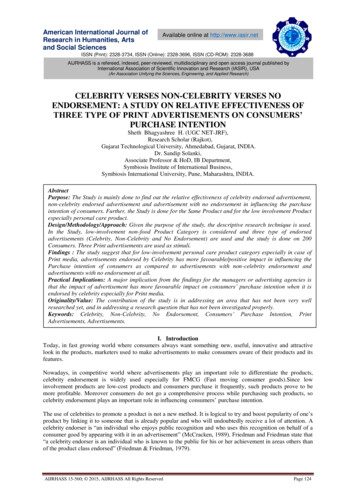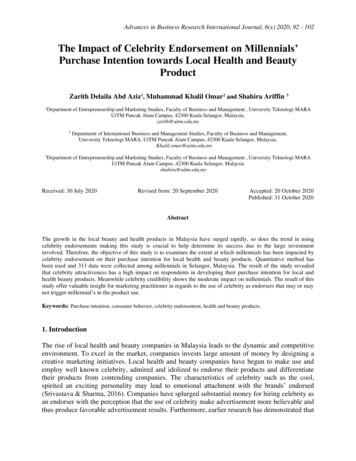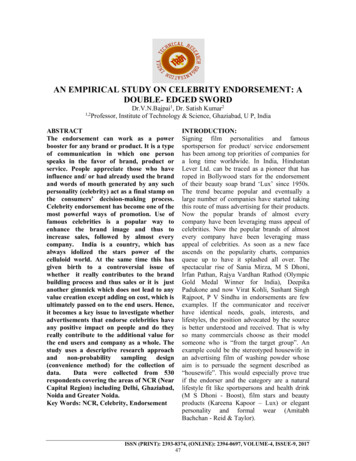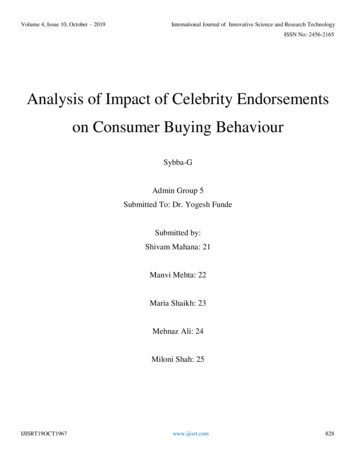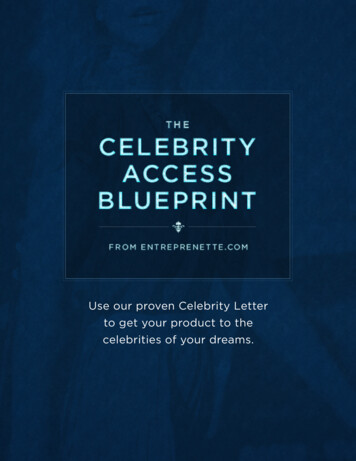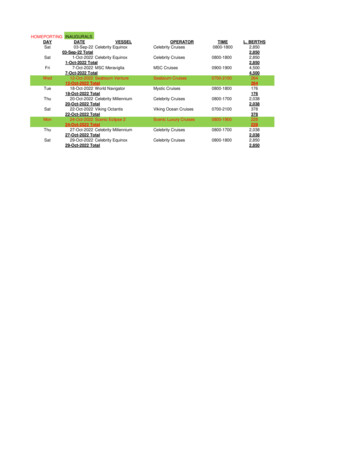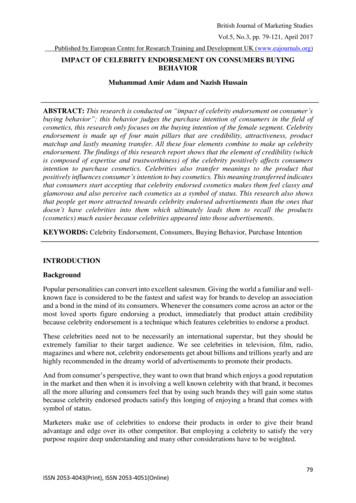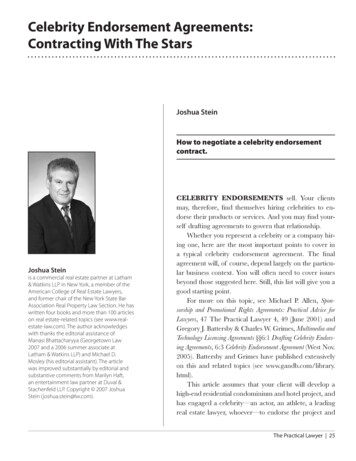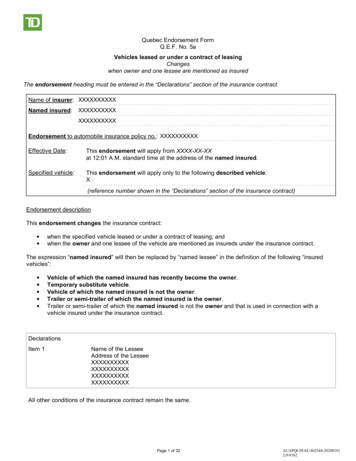
Transcription
Celebrity Endorsement - Consumers’willingness to pay for celebrity endorsedproductsMohammad KhederEkonomie, kandidat2018Luleå tekniska universitetInstitutionen för ekonomi, teknik och samhälle
AbstractCelebrity endorsement has become a widely studied and applied concept by the marketers andmanagers in modern business organizations. With the progressive marketing and businessmethods, new promotional tools have also been introduced to provide a competitive edge tothe organizations. This paper deals with the research question i.e. investigating the effects ofcelebrity endorsement on consumers' willingness to pay. The topic is examined through aqualitative method and inductive approach is adopted to proceed with the study. Secondarydata is collected through journals, online publications and forms the background knowledgeof the study. Primary data is obtained through eight semi-structured interviews conductedwith a sample comprising 5 football players located in the Norrbotten County. The outcomesindicate that 4 out of 5 respondents are willing to pay a higher price for the football shoes andequipment endorsed and promoted by the famous football players. However, the willingnessto pay varies due to income and substitution effects in different situations. However, it may beconcluded that celebrity endorsed products substantially influence the buyers' behavior tobuy.i
Table of ContentsChapter 1 - Introduction. 11.1 Background . 11.2 Problem discussion . 21.3 The Purpose. 21.4 Delimitation . 3Chapter 2 - Literature review . 42.1 Celebrity and Celebrity Endorsement . 42.2 Willingness to pay. 82.3 Effects of Celebrity Endorsements on Consumers' willingness to pay . 102.4 Frame of Reference. 11Chapter 3 - Methodology . 133.1 Research purpose . 133.2 Research approach . 143.3 Data collection. 153.4 Sample selection. 173.5 Research Analysis . 173.6 Reliability and validity. 18Chapter 4 - Results . 194.1 Inspiration . 194.2 Affiliation and Loyalty . 224.3 Value and Satisfaction. 23Chapter 5 - Conclusion . 24For future research . 24References . 25Appendix . 29Interview guide . 29ii
Chapter 1 - IntroductionIn this part of the project, the background of the topic will be presented followed by theproblem discussion. The main purpose and delimitations will also be presented.1.1 BackgroundOrganizations adopt different strategies to promote their products or brands. They includeadvertising on TV, newspapers and social media. However, a common promotion tool iscelebrity endorsement, which means that a well-known person represents the brand. Thecelebrity endorsement strategy is extremely useful in order to differentiate the brand andenhance competitive advantage (Spry et al., 2011). A celebrity is defined as an individual whopossesses public recognition and uses that recognition for the promotion of products, brandsor services (Pradhan et al., 2016). Celebrities are constantly being watched by people aroundthe world, which means that they are widely recognized and possess fame which helps themcapture people's attention. Therefore, their influence on a product, brand or purchaseintentions is huge (Sola, 2012). Celebrity endorsement can be seen as part of a company'sdesign and promotion of a brand. This practice has given an opportunity for companies tocreate a link between their brand and a well-known profile, like a celebrity (Jain and Roy,2016).Many reputed organizations have been using celebrity endorsements as a primary promotiontool for almost two decades. For instance, in 1997, Nike signed a five-year-long contract withthe legendary golf player, Tiger Woods. The partnership between Tiger Woods and Nikeresulted directly in terms of sales. In the first quarter, Tiger Woods endorsement doubled salesof Golf apparels and increased the total sales of the company with 55 percentage (Farrell etal., 2000). In total, Nike gained 103 million after getting endorsed by Tiger Woods (Chung,Derdenger & Srinivasan, 2013). A more recent and successful celebrity endorsement occurredwhen Volvo Cars hired Zlatan Ibrahimović for a new campaign, called Made By Sweden. Thesame weekend as the campaign got launched, the sales of Volvo Cars were boosted by 500percentage and its first quarter of 2014 measured an increase of 200 percentage in their sales(Byberg et al., 2015). Thus, it may be concluded that celebrity endorsement is greatlyeffective in increasing the sales of products and services.1
In order to increase the company's profit, one of the approaches is to gain knowledge aboutconsumers’ willingness to pay. Since celebrity endorsement leads to awareness and recalls(Spry et al., 2011), companies may work towards making consumers less price sensitive. Thismeans that customers will be willing to pay more for a product. Willingness to pay refers tothe maximum amount a customer is willing to pay for a product or service (Chatterjee &Kumar, 2017). Studies have shown that willingness to pay is linked to consumers’ valueperception of the product or service (Homburg et al., 2005). As has been seen in manyinstances that celebrity endorsements help in increasing the sales of the products or services,therefore we could posit that they have a direct influence on the consumers’ willingness topay.1.2 Problem discussionIt is widely known and researched that a celebrity endorsement is a great tool in contributingtowards boosting sales. Celebrities promote service and product in ways which help inbuilding credibility and brand awareness. By vouching for and advertising a product, celebrityendorsements increase trust, familiarity, and awareness, which are the significant factors indetermining the consumers' purchase decision-making process (Muda et al., 2017). It creates apsychological effect as people subconsciously believe that buying a celebrity-endorsedproducts will enable them to obtain the desired attributes of the celebrity. They also feel astrong connection and association with them and believe that the celebrities actually use theproducts they market. All these elements lead to a drastically increased and clear brand value,and the presence of legitimacy is visible in the company due to the power of the celebrity'sname supporting it. Consequently, the product's demand and sales are increased (Muda et al.,2017). However, in order to promote a product or service through celebrity endorsement, amanager needs to know exactly how the endorsement would affect consumers’ willingness topay, and what factors are likely to drive consumers' willingness to pay more. When a managergains access to all these details, only then he would know exactly what to focus on whenconducting such type of promotion. Therefore, the purpose of this study is to carry out adetailed research on this topic further.1.3 The PurposeThe purpose of the research is to find out how consumers’ willingness to pay is affected bycelebrity endorsement. This question is very important because celebrity endorsement is2
commonly being used by the companies as a significant promotional tool for their products orservices. It is important for the organizations to know how celebrity endorsement would affectconsumers’ willingness to pay. Based on that, the following research question has beenconstructed:How does celebrity endorsement affect consumers’ willingness to pay?1.4 DelimitationThis research will be delimitated into a consumer perspective as the purpose is to find out theconsumers’ experience and the impact of celebrity endorsement. In order to conduct thestudy, the effects of celebrity endorsement on the football industry have been chosen. Thereason for this choice is that sports have now become one of the potential disciplines in whicha higher number of people are engaged. The sports industry is making a stronger impactthrough its assumption to associate the promotional messages on a wider level by uniting theaudiences around the world through their passions. Therefore, celebrity endorsement play ahuge role in differentiating various sports brands and enhancing consumers' willingness topay. Furthermore, the methodology and data collection for the study will be delimited intothe football industry, where football players in Norrbotten county will be the primary datasource.3
Chapter 2 - Literature reviewThis chapter highlights previous findings and concepts that are relevant to this project. Theconcept of celebrity endorsement is presented and followed by an explanation of celebrity andwillingness to pay.2.1 Celebrity and Celebrity EndorsementA celebrity is defined as an individual who possesses public recognition and uses thatrecognition for the promotion of products, brands or services (Jain and Roy, 2016). In thesports world, celebrity is defined as a famous athlete or coach who uses the popularity topromote products, brands or services (Stafford et al., 2003). Celebrity endorsement is anadvertising tool, where celebrities are meant to promote a product, brand or service. This toolhas gradually become more common by advertisers. It is the spread of recognition, fame andthe high status the celebrities possess that is the key factors of celebrity endorsement (Jain andRoy, 2016). An endorsement implies that the well-known person will transfer his own valuesto the product, which means that the product or the brand will be linked to the celebrity(Pradhan et al., 2016).Johannes Knoll and Jörg Matthes (2017) claims that celebrity endorsement draws attention toa product, brand or service. Individuals that follow certain celebrity also get interested in whatthe celebrities advertise (Wi and Lu, 2013). That is because of the celebrities' popularitywhich makes consumers more motivated to appraise the endorsed products (Petty et al.,1983). Friedman (1979) mentions that consumers' purchase intentions increase with celebrityendorsement. In addition, the companies receive significantly more attention, recall rates andit enhances the brand equity. According to Pradhan et al., (2016), it is important to find awell-known person who can stand for the characteristics demanded by the consumers. Oncethe company has decided a known profile that is suitable for marketing the product or thebrand, it is necessary to design the campaign in such a manner that their values transfer to theproduct and are clearly perceived by consumers. It is relevant that these factors areaccomplished in order to maximize the endorsement of a well-known person (Pradhan et al.,2016). Therefore, it is important for a company to choose a suitable celebrity for theemployment, which is called match-up.4
In order to promote a successful celebrity endorsement and maximize the effect of celebrityendorsement, a company has to choose the most suitable celebrity for the brand or productthat is being promoted, which is called match-up. This is because the celebrity will berepresenting the promoted product. Essentially, the celebrity's values have to match-up withthe product or brand he or she is promoting (Byrne et al., 2003). Choi et al., (2005) points outthe importance of choosing an appropriate celebrity for the target market. Thus, not only is itimportant to choose a suitable celebrity for the promoted product, but the chosen celebrityalso needs to be the most appropriate one towards the target market. On some occasions, it ismore effective to use a local celebrity rather than a foreign celebrity (Choi et al., 2005).There are four criteria that need to be fulfilled to choose the right celebrity (Miciak andShanklin, 1994). Celebrity credibility is a criterion where the main point is that the chosencelebrity has to be trustworthy. Celebrity/audience match is a criterion that emphasizes thatthe chosen celebrity must be popular in the eyes of the target market. At this stage, a companycan use either a local celebrity or a foreign celebrity. Therefore, it is important that a companychooses the most suitable celebrity for the target market (Miciak and Shanklin, 1994).Celebrity/product match is a criterion which emphasizes that the celebrity's values and imagemust match-up with the promoting product or service. Celebrity attractiveness points out thatthe representative celebrity must be popular. He or she has to be recognized by name, looksand working associations (Miciak and Shanklin, 1994). According to Khatri (2006), acompany can use a celebrity in different ways, and he brings up four characters that acelebrity can act. Those are testimonial, endorsement, actor, and spokesperson, which areexplained below.Testimonial means that a celebrity uses or tests a product or a service and then praises theproducts or service's attribute in a statement. This could be done in writing as well as in oralform (Khatri, 2006). An example of this is the testifying of former football star DavidBeckham for the quality of Gillet's razors (Thomaselli, 2004, April 27).The endorsement is when celebrities lend their names to companies, for using it in theadvertisement of products or services, regardless of the extent of expertise about the actualproduct or service (Khatri, 2006). This is when Cristiano Ronaldo and the Portuguese hotelchain Pestana started to collaborate, where they used Ronaldo’s signature name, CR7, as thehotel's name (Soo, 2016, August 4).5
Figure 1: Celebrity Endorsement Example 1The endorsement is when celebrities lend their names to companies, for using it in theadvertisement of products or services, regardless of the extent of expertise about the actualproduct or service (Khatri, 2006). This is when Cristiano Ronaldo and the Portuguese hotelchain Pestana started to collaborate, where they used Ronaldo’s signature name, CR7, as thehotel's name (Soo, 2016, August 4).Figure 2: Celebrity Endorsement Example 26
Involvement of a celebrity in an advertisement as an actor means that he or she will bepresenting a product or a service in the advertisement as a character. The difference betweenbeing an actor and the first two roles is that in an act, a celebrity is a certain character in theactual advertisement rather than being himself (Khatri, 2006). A clear example of acting is thecommercial made by the chips company Lays featuring football superstar Lionel Messi[figure 3] (Bruck, 2014, June 16).Figure 3: Celebrity Endorsement Example 3Spokesperson, via agreements, is when a celebrity has the role of being representative of abrand on behalf of a company over the arranged period. Spokespersons are in simple termsthe face and voice of the brand. This type of role gets a higher response in terms of attention,recall, and awareness (Khatri, 2006). An example of this is the agreement between Nike andthe legendary Micheal Jordan. Nike and Micheal Jordan started a new shoe collection,basketball shoes mixed with sneakers, and named that collection after Micheal Jordan, AirJordan [Figure 4]. Not only did they name it Air Jordan, but they also positioned MichealJordan as the spokesperson (Rovell, 2013, February 16).7
Figure 4: Celebrity Endorsement Example 42.2 Willingness to payIn order to design an optimal pricing strategy, the focus should be placed on setting the pricesof products by considering consumers' willingness to pay for them. To increase the prices ofproducts, a company needs knowledge about customers' willingness to pay. According toHomburg et al., (2005) willingness to pay is defined as the maximum amount of money that aconsumer is prepared to pay for a product. This term measures the maximum price aconsumer is willing to pay for a product before substituting for another product (Homburg etal., 2005). It is vital for a manager to have great knowledge of consumers’ willingness to paywhen calculating and predicting product demand. With the help of this knowledge, themanager can plan optimal price strategies for the products in order to maximize the profit andreturn on the investments (Sukhu et al., 2017). An appropriate price strategy for companies touse is customer value-based pricing strategy where the focus of the price setting is onconsumers’ willingness to pay (Hinterhuber, 2008). Moreover, Wertenbroch and Skiera(2002) explain that a buyer's willingness to pay is at least as high as the posted prices bycompanies, and nonbuyers willingness to pay is lower than the posted price.Homburg et al., (2005) claimed that willingness to pay is connected with customersatisfaction. In 1996, Anderson made an effort in finding that an increased customersatisfaction leads to an increased brand loyalty and that in turn lead to lower price sensitivitywhich means that they are willing to pay more. Meier (2017) discuss that consumers’8
willingness to pay varies depending on the perceived quality and value of the product. Busler(2002) also discusses the quality as an influencing factor of willingness to pay, but theperformance of the product has a role as well. Another factor that can have an impact on thewillingness of pay is time. Arbin and Holmberg (2005) claim that time can have a relativelyhuge effect on consumers’ willingness to pay. A consumer’s willingness to pay for anexample of a Coca-Cola drink on a hot day can be more than on a cold day (Arbin andHolmberg, 2005). Since football, in many countries, is not played all year around, thewillingness to pay for football equipment can therefore vary.In Hanemann’s (1991) study of willingness to pay and willingness to accept, he highlightstwo major influencing factors, namely the substitution effect, and income effect. These twofactors have a big role in willingness to pay. The substitution effect is the simplicity withwhich products can be substituted for another product. Hanemann (1991) claims that the moresubstituted products are available in the market the less is the consumer willing to pay, and incontrast, the less substituted products there is the more is a consumer willing to pay. The otherfactor, income effect, is an effect the income has on the demand for the product, whichindirectly affects the willingness to pay. The income effect is determined by the incomeelasticity, which is the percentage alteration of the income that results in alteration of aproduct's or service's demand (Ramskov and Munksgaard, 2001). The higher income aconsumer has, the more is the consumer willing to pay. Conversely, the lower income aconsumer has, the less is the consumer willing to pay (Hanemann, 1991).The decision making process about consumers' willingness to pay includes value, acceptableprice, and reference price. Satisfaction and culture also influence buyers' decisions. Accordingto Davvetas (2015), reference price (RP) is defined as the price which is used by the buyers asa basis against which they compare the new prices that are offered by the seller. Value isdefined as the assessment of consumers' experiences with the purchased object on the basis ofbenefits and sacrifices attached to it (Davvetas, 2015). Willingness to pay definitelycorresponds the optimal level of monetary benefits and sacrifices that the customers agree tomake as compensation for the benefits achieved by the product (Rehdanz & Sundt, 2015).It is essential for a company to understand the customer's willingness to pay before startingany negotiations. Managers need to develop relevant strategies in order to realize the prices oftheir products. Salespeople are usually dependant on their selling skills and experience forunderstanding the ways in which customers value the products and make purchase decisions.9
However, there are different factors that impact the buyers' willingness to pay. Price vs.quality effect describes buyers' willingness to pay more when they are of the opinion that highprice signifies a high-quality product (Campbell et al., 2014). According to (Chatterjee &Kumar (2017), unique value effect also influences buyers' willingness to pay. If the unique ordistinctive attributes of the product are valued by the buyers, they will pay more. Accordingto expenditure effect, the willingness of the buyers to purchase an item will decline if the totalexpenditures are higher. Besides this, various macro-environmental factors may also havemajor impacts on the buyers' willingness (Chatterjee & Kumar, 2017). For instance, aneconomic recession may demand consumers to pay lesser in comparison to the conditions ofeconomic boom. The perception of the buyers regarding the falling or rising prices ofproducts in the future may also influence their willingness to pay for the products, ultimately,enhance their willingness to pay for these products (Chatterjee & Kumar, 2017).2.3 Effects of Celebrity Endorsements on Consumers' willingness to payThe strategy of celebrity endorsement is feasible and extremely beneficial in order to buildcredibility, promote products, and increase brand awareness. Almost 20 percentage of all theadvertisements aired on televisions in the United States feature brands and products that arecelebrity endorsed (Albert et al., 2017). According to statistics, Nike spends almost 480million every year on endorsing their brand by athletes (Slater, 2018). There are endlessbenefits of celebrity endorsements for the company, product, and the consumers.According to Wadhera & Chawla (2015), the celebrity endorsement results in boosting salesof the product and help attracting new consumers for the business. They inspire theconfidence of the consumers and motivate their purchase intentions positively. The additionof the brand value is clear and immediate. As soon as a celebrity signs the agreement toendorse a product, the company obtains a factor of legitimacy due to the strength of acelebrity's name (Wadhera & Chawla, 2015). Signing celebrity endorsement contract resultsin an immediate rise of 25 per cent in the stock when the news goes public thus, representinga boost in the perceived legitimacy of the company, although the fact that the product is same.According to studies, advertisements using a celebrity, who is admired by people, tend todraw the attention of the audience more quickly and easily than some other standard,traditional designed advertisement (Wadhera & Chawla, 2015). Therefore, one of the manypositive outcomes of celebrity endorsement is that the brand image is refreshed, consumerawareness is enhanced, attention is gained and a new dimension is added to the brand image.10
According to a study, consumers tend to present a better recall for the products or servicesthat are celebrity endorsed even if they are not the actual fan. The human brain is used torecognizing celebrities just like the way it recognizes and values people it actually knows. Asan impact of this, consumers tend to position the celebrity endorsed products on a higher level(Lim et al., 2017). Thus, a psychological impact is created resulting in the consumers'increased willingness to pay.In addition to the many other existing benefits of celebrity endorsements, awareness alongwith familiarity and trust is increased when a celebrity vouches for or promotes a product.These are the essential variables in the purchase decision-making process of the consumer.They possess more sympathetic feelings for a brand if it is promoted by their favoritecelebrity (Dwivedi et al., 2015). Moreover, a psychological impact is created which letsconsumers believe subconsciously that buying a product advertised by their admired celebritywill help them in imitate the desired traits of the celebrity. This increases their willingness topay and thus lead to a boost in sales.Although many research shows that celebrity endorsements affect willingness to pay yet finerunderstanding of why and how it affects in the context of consumer is still not understoodwell. It may be their loyalty and affiliation with the celebrity, the pride that they feel byassociating themselves with a high performing football player or the satisfaction and valuethat they obtain from celebrity endorsed products. It can be anything ranging frommaintaining a status quo to gaining personal satisfaction and benefits by consuming acelebrity endorsed product.2.4 Frame of ReferenceThe study mainly focuses on consumers' willingness to pay for the celebrity endorsedproducts. In order to proceed with the research question, the main concepts that are identified,including studying celebrity endorsement as marketing and promotional tool, and willingnessto pay as the consumers' ability to make purchase decisions. Celebrity endorsement is definedas a commonly used promotion tool where famous people are used for promotion of a productor service. Previous findings emphasized that celebrity endorsement have an effect onconsumers’ willingness to pay (Busler, 2002). According to Busler (2002), an advertisementgets more credible and relevant when a favorable celebrity endorser is involved. Willingnessto pay is defined as the maximum amount of money a consumer is prepared to pay for a11
product. This term measures the maximum price a consumer is willing to pay for a productbefore substituting for another product (Homburg et al., 2005).Both concepts, celebrity endorsements and consumer's willingness to pay are related to eachother in practice. The celebrity endorsed products tend to boost consumer's willingness to payfor them by attracting them psychologically. In order to investigate how celebrityendorsement affects willingness to pay, following theoretical framework serves as a guidingtool for the empirical dorsmentCelebrity EndorsementAttentionSubstitution effectInterestBrand loyaltyWillingness to payMotivationIncome effectFigure 5: Frame of referenceThe current study takes into consideration the effects of celebrity endorsements on consumer'swillingness to pay for a product. The literature review provided above discusses concepts indetail. The following chapters in the thesis will be a detailed investigation of concepts shownin the figure 5. Through qualitative research, primary and secondary data will be gathered inan attempt to study the impacts of celebrity endorsement of football equipment andconsumers willingness to pay after being inspired and motivated. In addition to this, the tradeoffs such as income and substitution effects will also be discussed which are likely toinfluence the purchase decision-making process.12
Chapter 3 - MethodologyThis chapter presents the methodology of the research; it discusses the choices and motives ofmethods. The methodology chapter is divided into research purpose, research approach, datacollection, research analysis, sample selection, and reliability and validity which all will beintroduced and explained in detail below.A method according to Saunders et al., (2009, p. 3) is “ the techniques and procedures usedto obtain and analyze research data. This includes examples of questionnaires, observations,interviews, and statistical and non-statistical techniques". The description in the methodexplains how and why the particular research has been applied. The approaches and choicesof this study are discussed in the following sections.3.1 Research purposeBy using scientific procedures, a research purpose focuses on gathering answers to questions.The research purpose is dependent on the main research problem, as it helps the author decidethe research
concept of celebrity endorsement is presented and followed by an explanation of celebrity and willingness to pay. 2.1 Celebrity and Celebrity Endorsement A celebrity is defined as an individual who possesses public recognition and uses that recognition for the promotion of products, brands or services (Jain and Roy, 2016). In the
